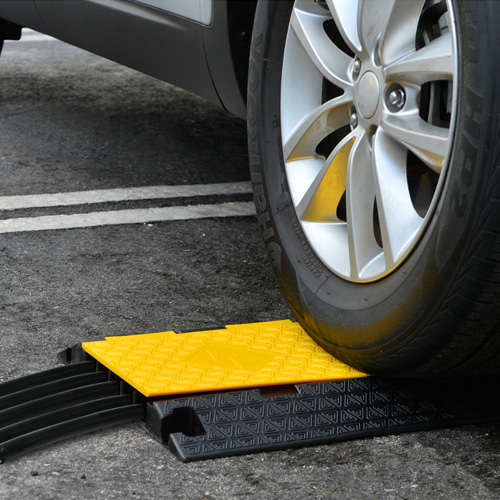Overview
Introduction to traffic speed bumps
Traffic speed bumps are an essential tool in ensuring road safety. These raised structures are strategically placed on roads to slow down vehicle speeds, thereby reducing the risk of accidents. By forcing drivers to reduce their speed, speed bumps help to prevent reckless driving and encourage responsible behavior on the road. Additionally, speed bumps are particularly effective in areas with high pedestrian traffic, such as school zones or residential areas, as they create a safer environment for pedestrians by deterring speeding vehicles. Overall, the presence of traffic speed bumps plays a crucial role in promoting safer roads and protecting the well-being of both drivers and pedestrians.
Purpose of traffic speed bumps
The purpose of traffic speed bumps is to slow down vehicles and reduce their speed in specific areas. By strategically placing speed bumps on roads, especially in residential areas, school zones, and areas with high pedestrian traffic, the aim is to enhance road safety and prevent accidents. Speed bumps serve as a visual and physical reminder for drivers to adhere to the speed limit and drive more cautiously. They help to control the flow of traffic, discourage reckless driving, and create a safer environment for pedestrians and other road users.
Statistics on road accidents
According to recent statistics, road accidents are a major concern worldwide. Every year, millions of people are injured or killed in road accidents, causing immense pain and suffering to families and communities. In many cases, excessive speed is a leading factor in these accidents. Speed bumps play a crucial role in reducing the speed of vehicles and ensuring safer roads. Studies have shown that the presence of speed bumps can significantly decrease the number of accidents and save lives. Therefore, it is important to recognize the significance of traffic speed bumps in road safety initiatives.
Benefits of Traffic Speed Bumps
Reducing vehicle speed
One effective way to reduce vehicle speed and enhance road safety is through the use of traffic speed bumps. Traffic speed bumps are physical obstacles placed on the road surface that force drivers to slow down. By introducing these bumps in strategic locations, such as residential areas, school zones, and busy intersections, the speed of vehicles can be significantly reduced. This helps to prevent accidents, especially those caused by speeding, and protects pedestrians and other road users. Additionally, traffic speed bumps also serve as a visual reminder for drivers to be cautious and adhere to speed limits, promoting a safer driving culture.
Enhancing pedestrian safety
One of the key ways to enhance pedestrian safety on roads is through the installation of
traffic speed bumps. These physical road features are designed to slow down the speed of vehicles, especially in areas with high foot traffic. By reducing the speed of vehicles, traffic speed bumps help to create a safer environment for pedestrians, as it gives them more time to react and cross the road safely. Additionally, traffic speed bumps also serve as a visual reminder for drivers to be more cautious and aware of their surroundings, further promoting pedestrian safety. Overall, the presence of traffic speed bumps plays a crucial role in enhancing pedestrian safety on roads.
Preventing accidents in residential areas
One effective way to prevent accidents in residential areas is by installing traffic speed bumps. These bumps are designed to slow down vehicles and force drivers to be more cautious while driving. By reducing the speed of vehicles, traffic speed bumps help to create a safer environment for pedestrians, cyclists, and other road users. They also serve as a visual reminder for drivers to stay alert and be mindful of their surroundings. Additionally, traffic speed bumps can discourage reckless driving and deter speeding, which are common causes of accidents in residential areas. Overall, the presence of traffic speed bumps can significantly contribute to the prevention of accidents and the promotion of road safety in residential areas.
Types of Traffic Speed Bumps
Traditional speed bumps
Traditional speed bumps are a common feature on roads and highways around the world. They are designed to slow down vehicles and improve road safety by forcing drivers to reduce their speed. These speed bumps are typically made of concrete or asphalt and are placed strategically in areas where speeding is a concern, such as residential neighborhoods, school zones, and parking lots. While effective in reducing speed, traditional speed bumps can also cause discomfort and inconvenience for drivers and passengers. The abrupt changes in elevation can lead to a bumpy ride and potential damage to vehicles. Additionally, they may contribute to noise pollution and increase the risk of accidents if drivers fail to slow down in time. As road safety measures continue to evolve, alternative solutions to traditional speed bumps are being explored to strike a balance between traffic calming and driver comfort.
Speed humps
Speed humps, also known as speed bumps, are an essential tool in ensuring road safety. These raised sections of pavement are designed to slow down the speed of vehicles, particularly in areas where there is a high risk of accidents or where speed limits are frequently exceeded. By forcing drivers to reduce their speed, speed humps help to prevent collisions, protect pedestrians, and create a safer environment for everyone on the road. Additionally, speed humps can also serve as a visual reminder for drivers to be cautious and attentive while driving. Overall, the presence of speed humps plays a crucial role in promoting responsible driving behavior and reducing the likelihood of accidents.
Speed cushions
Speed cushions are a type of traffic calming measure that are designed to reduce vehicle speed in residential areas. They are typically installed on roads where there is a need to slow down traffic, such as near schools, parks, or residential neighborhoods. Speed cushions are raised platforms that are placed across the road, forcing drivers to slow down and navigate over them. They are effective in slowing down vehicles without causing discomfort or damage to cars. The cushions are designed to allow emergency vehicles, buses, and bicycles to pass through without any disruption. By reducing vehicle speed, speed cushions help improve road safety by minimizing the risk of accidents and protecting pedestrians and cyclists.
Installation and Design Considerations
Proper placement of speed bumps
Proper placement of speed bumps is crucial in ensuring road safety. Speed bumps should be strategically placed in areas where there is a high risk of speeding or where there is a need to control traffic flow. They are commonly installed near schools, residential areas, and pedestrian crossings to slow down vehicles and protect vulnerable road users. It is important to consider factors such as visibility, signage, and the impact on emergency services when determining the placement of speed bumps. By placing speed bumps in the right locations, we can effectively reduce speeding and enhance overall road safety.
Design specifications for effective speed bumps
When designing speed bumps for effective road safety, there are several important specifications to consider. Firstly, the height of the speed bump should be appropriate to ensure that vehicles are forced to slow down without causing damage to the vehicle or discomfort to the passengers. Additionally, the width of the speed bump should be wide enough to cover the entire width of the road, ensuring that all vehicles are required to slow down. The material used for the speed bump should be durable and able to withstand heavy traffic and various weather conditions. Finally, the placement of speed bumps should be strategic, considering factors such as visibility, pedestrian safety, and the flow of traffic. By adhering to these design specifications, speed bumps can effectively contribute to road safety by reducing speeding and promoting safer driving behavior.
Considerations for accessibility and drainage
When installing traffic speed bumps, it is crucial to consider accessibility and drainage. These factors play a significant role in ensuring the safety and functionality of the road. Accessibility considerations involve ensuring that the speed bumps are designed in a way that does not hinder the movement of pedestrians, cyclists, and individuals with disabilities. The height and slope of the speed bumps should be carefully planned to provide a smooth transition for all road users. Additionally, proper drainage is essential to prevent water accumulation and maintain the integrity of the road surface. Adequate drainage systems should be implemented to ensure that the speed bumps do not become obstacles during heavy rainfall or flooding. By taking these considerations into account, traffic speed bumps can effectively enhance road safety while maintaining accessibility and proper drainage.
Controversies and Challenges
Impact on emergency response vehicles
Traffic speed bumps can have a significant impact on the response time of emergency vehicles. These bumps are designed to slow down vehicles and ensure safer driving conditions for the general public. However, for emergency response vehicles such as ambulances and fire trucks, the presence of speed bumps can delay their arrival to critical situations. The need to slow down or navigate carefully over the bumps can add precious seconds or even minutes to their response time. This delay can potentially jeopardize the lives of those in need of urgent medical attention or rescue. Therefore, it is crucial to carefully consider the placement and design of speed bumps to minimize their impact on emergency response vehicles while still maintaining road safety for all road users.
Noise and vibration concerns
One of the main concerns associated with traffic speed bumps is the noise and vibration they generate. As vehicles pass over the bumps, they create a significant amount of noise, especially if they are not designed properly. This noise can be a nuisance for nearby residents, particularly during the night when it can disrupt sleep. Additionally, the vibrations caused by the bumps can also be felt by people living in close proximity to the road, which can be uncomfortable and potentially damaging to nearby structures. Therefore, when implementing traffic speed bumps, it is crucial to consider the potential noise and vibration impacts and take necessary measures to minimize them.
Balancing traffic calming with traffic flow
When it comes to road safety, finding the right balance between traffic calming measures and maintaining smooth traffic flow is crucial. Traffic speed bumps are one such measure that plays a significant role in achieving this balance. While speed bumps effectively slow down vehicles, they can also cause traffic congestion and delays, especially in high-traffic areas. Therefore, it is important to strategically place speed bumps in a way that they effectively calm traffic without significantly disrupting the flow of vehicles. This requires careful consideration of factors such as road design, traffic volume, and speed limits. By striking the right balance between traffic calming and traffic flow, we can create safer roads for both pedestrians and drivers.
Conclusion
The importance of traffic speed bumps in road safety
Traffic speed bumps play a crucial role in ensuring road safety. These raised structures are strategically placed on roads to slow down vehicles and reduce their speed. By doing so, speed bumps help prevent accidents, especially in areas with high pedestrian traffic or near schools and residential areas. They serve as a visual and physical reminder for drivers to be cautious and adhere to the speed limit. Additionally, speed bumps also contribute to traffic calming measures, reducing the likelihood of reckless driving and promoting a safer environment for everyone on the road. Overall, the presence of traffic speed bumps significantly enhances road safety and helps protect the lives of both drivers and pedestrians.
Continued research and improvement
Continued research and improvement are crucial in ensuring the effectiveness of traffic speed bumps in road safety. As technology advances and new materials become available, it is important to explore and evaluate their potential in creating better and more efficient speed bumps. Additionally, ongoing research can help identify any drawbacks or limitations of existing speed bump designs and find innovative solutions to overcome them. By continuously striving for improvement, we can enhance the overall safety and effectiveness of traffic speed bumps, ultimately making our roads safer for everyone.
Collaboration between stakeholders for effective implementation
The effective implementation of traffic speed bumps requires collaboration between various stakeholders. This includes government agencies, road safety organizations, traffic engineers, and local communities. These stakeholders need to work together to identify areas where speed bumps are needed, determine the appropriate design and placement of the bumps, and ensure ongoing maintenance and monitoring. Additionally, collaboration is crucial for raising awareness among drivers and pedestrians about the importance of adhering to speed limits and respecting the presence of speed bumps. By working collaboratively, stakeholders can create a safer road environment and reduce the risk of accidents caused by excessive speeding.

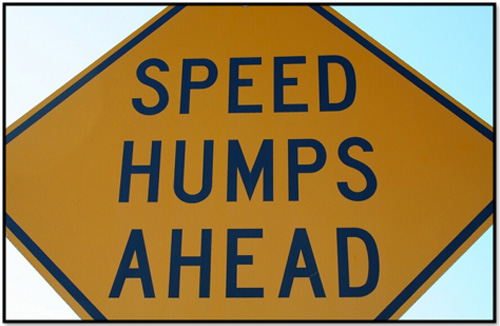 Our products will give you total satisfaction and your roads will be safe and people as well, areas like parking lots and much more will be protected.
Our products will give you total satisfaction and your roads will be safe and people as well, areas like parking lots and much more will be protected.
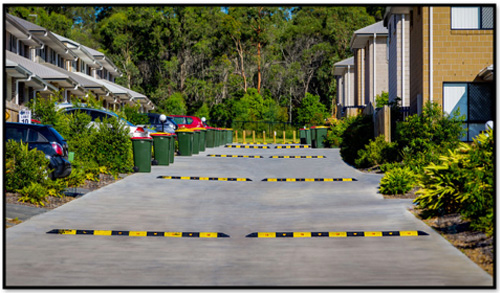 There’s no better way to keep the road safe than allowing speed humps do their work by keeping the vehicles speed slow and safe for pedestrians to cross. Call now to our Sales Department and you’ll be happily attended by one of our Representatives.
Speed humps are legal for authorized use on public roads and any other area where they might be needed to increase safety. Reflective yellow stripes for high-visibility at night and in bad weather are part of its DNA creating a very high quality product that really works for safety wherever it is installed.
Made with high quality EPDM rubber compound, 25% recycled rubber content. Our 6’ portable speed bump have many benefits and they are very easy to install, some of the great benefits are:
There’s no better way to keep the road safe than allowing speed humps do their work by keeping the vehicles speed slow and safe for pedestrians to cross. Call now to our Sales Department and you’ll be happily attended by one of our Representatives.
Speed humps are legal for authorized use on public roads and any other area where they might be needed to increase safety. Reflective yellow stripes for high-visibility at night and in bad weather are part of its DNA creating a very high quality product that really works for safety wherever it is installed.
Made with high quality EPDM rubber compound, 25% recycled rubber content. Our 6’ portable speed bump have many benefits and they are very easy to install, some of the great benefits are:
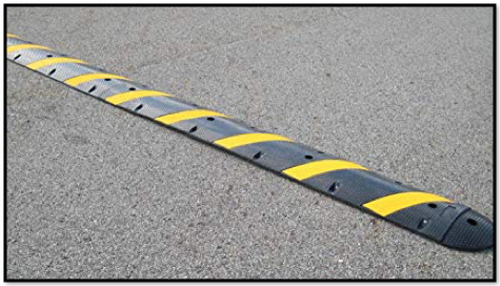 The sooner you know the traffic signals much better, this should be the basic premise of this type of courses. Throughout the courses, children, among other things, learn the meaning of: pedestrian crossing, bus stop, direction required, forbidden direction, traffic light (what is, their implications in the passage of pedestrians, and others)
In this way they learn to differentiate all elements of public roads: sidewalk, curb and road, knowing where and how to cross.
Speed bump and speed hump, both are designed to address the ongoing problem of speeding. Both are usually made of rubber tires and constructed with a reflective tape to ensure maximum visibility. Installing these traffic control devices is a great way to reduce injuries. Many drivers will travel past and ignore the painted lines on surfaces and the stop signs, but these speed bumps and speed humps cannot be ignored by speeding drivers. These tactical insertions on the road promote awareness and make drivers sensitive to speeding consequences.
Factors to consider:
The sooner you know the traffic signals much better, this should be the basic premise of this type of courses. Throughout the courses, children, among other things, learn the meaning of: pedestrian crossing, bus stop, direction required, forbidden direction, traffic light (what is, their implications in the passage of pedestrians, and others)
In this way they learn to differentiate all elements of public roads: sidewalk, curb and road, knowing where and how to cross.
Speed bump and speed hump, both are designed to address the ongoing problem of speeding. Both are usually made of rubber tires and constructed with a reflective tape to ensure maximum visibility. Installing these traffic control devices is a great way to reduce injuries. Many drivers will travel past and ignore the painted lines on surfaces and the stop signs, but these speed bumps and speed humps cannot be ignored by speeding drivers. These tactical insertions on the road promote awareness and make drivers sensitive to speeding consequences.
Factors to consider:
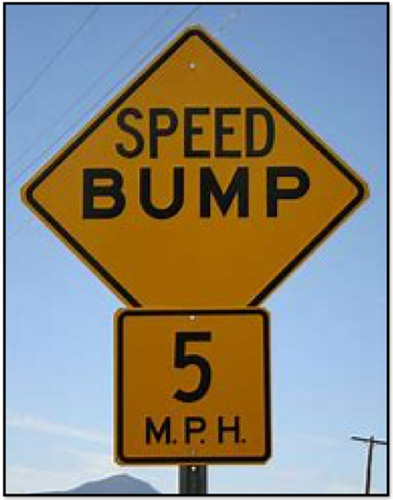 Speed bumps are abrupt raised areas, typically 2–3 inches high with a travel length of 12 inches, that can be comfortably crossed at speeds of 5 miles per hour or less. Crossing at higher speeds can cause significant discomfort for the vehicle’s occupants. Because speed bumps require an immediate and dramatic slowdown, they are often considered to be a liability risk on public streets and other roads where higher speeds are allowed. If you need a speed-control solution for low-speed areas, such as parking lots, garages, and low-traffic private roads, speed bumps would be a good option.
Speed humps are designed to slow vehicles while maintaining traffic flow, with a gentler rise and a lower peak height. Their design allows drivers to cross comfortably without sudden braking, allowing traffic to flow smoothly while still controlling speed. Speed humps are ideal for entertainment venues that accommodate large volumes of traffic, and they are also recommended for residential streets with speed limits of 25 miles per hour or less. If you need a solution for higher-speed areas where smooth traffic flow is essential, consider opting for speed humps.
Maintain a safe pedestrian environment by slowing down vehicle traffic with our 6′ Speed Bump. Our prices are the lowest in the market and they include the hardware, the 6 foot speed bump can permanently be installed on asphalt or concrete using its pre-drilled countersink mounting holes. Maintain a safe pedestrian environment by slowing down vehicle traffic with our great 6’ heavy-duty economy speed bumps. Our products will give you total satisfaction and your roads will be safe and people as well, areas like parking lots and much more will be protected.
Speed bumps are abrupt raised areas, typically 2–3 inches high with a travel length of 12 inches, that can be comfortably crossed at speeds of 5 miles per hour or less. Crossing at higher speeds can cause significant discomfort for the vehicle’s occupants. Because speed bumps require an immediate and dramatic slowdown, they are often considered to be a liability risk on public streets and other roads where higher speeds are allowed. If you need a speed-control solution for low-speed areas, such as parking lots, garages, and low-traffic private roads, speed bumps would be a good option.
Speed humps are designed to slow vehicles while maintaining traffic flow, with a gentler rise and a lower peak height. Their design allows drivers to cross comfortably without sudden braking, allowing traffic to flow smoothly while still controlling speed. Speed humps are ideal for entertainment venues that accommodate large volumes of traffic, and they are also recommended for residential streets with speed limits of 25 miles per hour or less. If you need a solution for higher-speed areas where smooth traffic flow is essential, consider opting for speed humps.
Maintain a safe pedestrian environment by slowing down vehicle traffic with our 6′ Speed Bump. Our prices are the lowest in the market and they include the hardware, the 6 foot speed bump can permanently be installed on asphalt or concrete using its pre-drilled countersink mounting holes. Maintain a safe pedestrian environment by slowing down vehicle traffic with our great 6’ heavy-duty economy speed bumps. Our products will give you total satisfaction and your roads will be safe and people as well, areas like parking lots and much more will be protected.
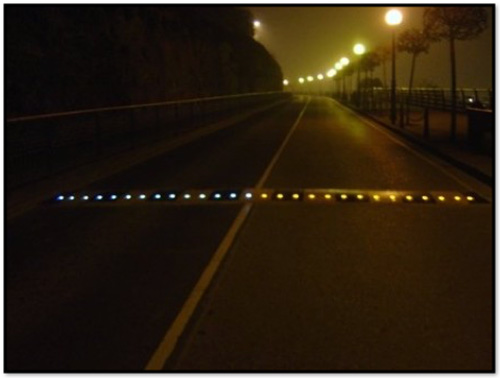 Removable Speed bumpers allow permanent installation with Optional Steel Spikes for use in asphalt and Lag Bolts and Lead Shields for use in concrete. In our great prices we include hardware and we offer great 5 years Warranty. Please give us a call and one of our sales representatives will be more than happy to assist you!
Removable Speed bumpers allow permanent installation with Optional Steel Spikes for use in asphalt and Lag Bolts and Lead Shields for use in concrete. In our great prices we include hardware and we offer great 5 years Warranty. Please give us a call and one of our sales representatives will be more than happy to assist you!
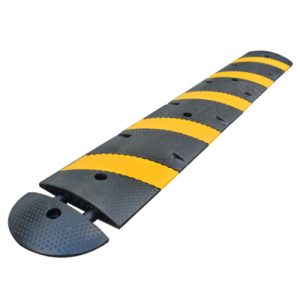

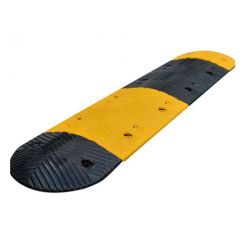

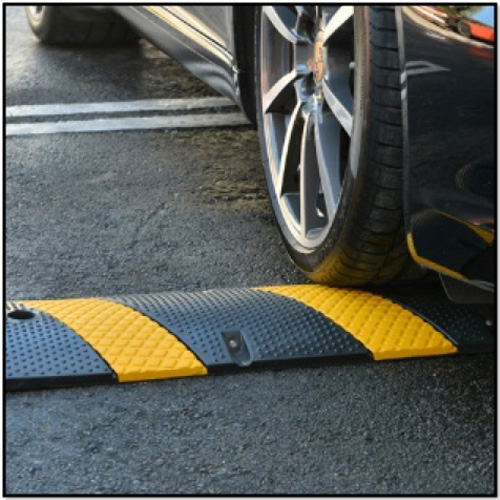



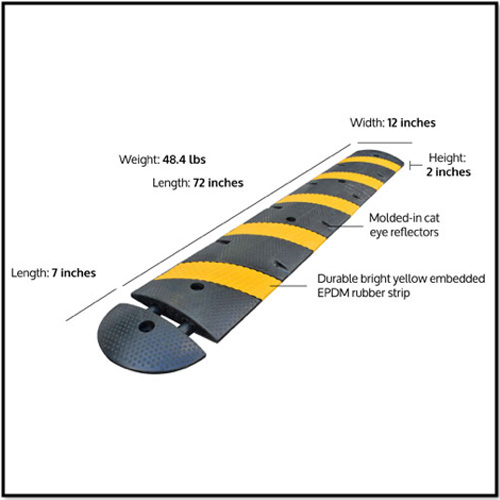
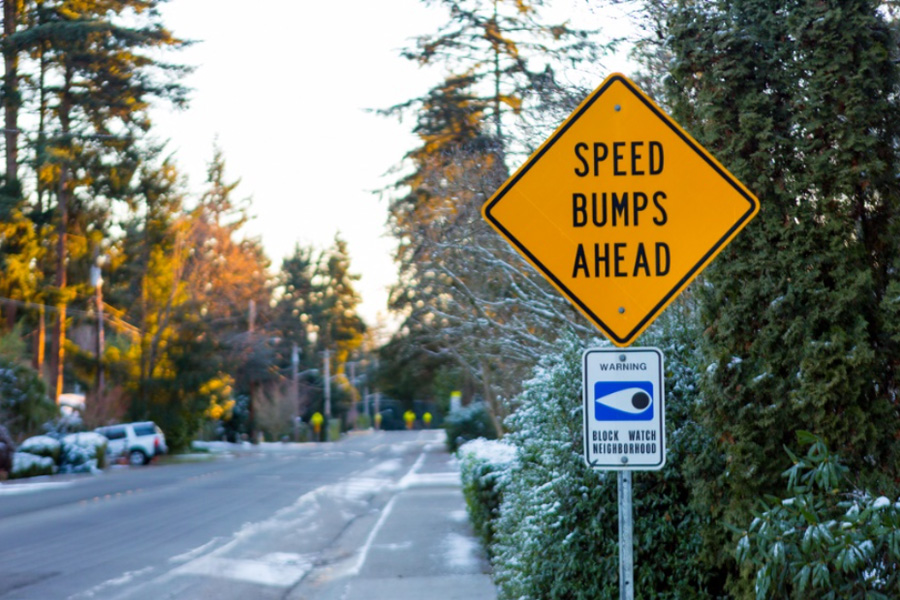 Our speed bumps come in 12 feet wide which is a perfect size for cars to slow down safety, this product is widely used because of their ease of installation and low cost, they are the ideal solution to make drivers to reduce their speed.
Our speed bumps come in 12 feet wide which is a perfect size for cars to slow down safety, this product is widely used because of their ease of installation and low cost, they are the ideal solution to make drivers to reduce their speed.
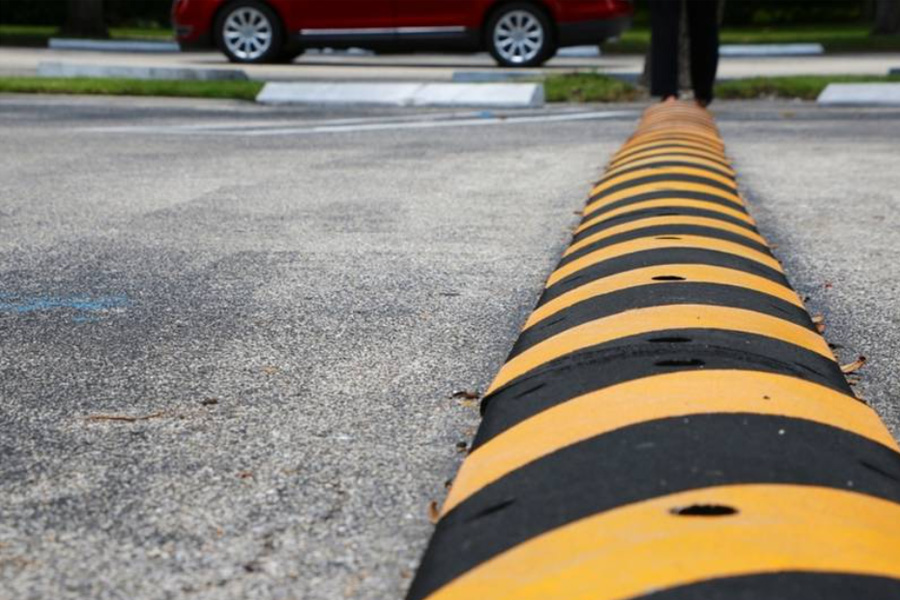 There are many benefits about using speed bumps to make your roads a safer place, they are Ideal to be used in areas like: parking lots, schools, public playgrounds, hospitals zones and residential & industrial areas. Also Very easy to assemble, installation can be placed on concrete or asphalt. Another great quality is that speed bumps are perfect for any type of weather conditions, this product is very resistant, will not crack or break. We have the best prices and mounting screw are included in the price and in addition we offer great 5 years warranty. Call us now for a free estimate our main priority is customer service.
There are many benefits about using speed bumps to make your roads a safer place, they are Ideal to be used in areas like: parking lots, schools, public playgrounds, hospitals zones and residential & industrial areas. Also Very easy to assemble, installation can be placed on concrete or asphalt. Another great quality is that speed bumps are perfect for any type of weather conditions, this product is very resistant, will not crack or break. We have the best prices and mounting screw are included in the price and in addition we offer great 5 years warranty. Call us now for a free estimate our main priority is customer service.
